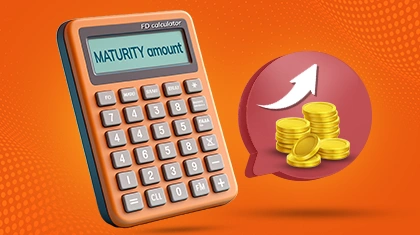THE
ORANGE
HUB
Why Do Fixed Deposit Interest Rates Fluctuate?

Reliable returns and an easy way to grow money over time are two major reasons why people choose a Fixed Deposit (FD) in India. FDs are a safe way to invest your money and let it grow with time. However, it is also important to note that FDs are subject to fluctuating interest rates. This increase and decrease in FD interest rates creates curiosity among investors regarding the reasons behind such variations. In this blog post, let’s learn about these fluctuations and understand the factors influencing the changes in FD interest rates.
Fluctuations in Fixed Deposit interest rates
Banks update interest rates of FDs as per the repo rate issued by the Reserve Bank of India (RBI). FD interest rates increase if the repo rate increases. It is beneficial to keep an eye on these updates from RBI to help you make sound financial decisions.
What are the reasons behind the fluctuations in Fixed Deposit interest rates?
The following reasons affect the interest rates of FDs in India:
Inflation Rates and RBI’s Monetary Policy
Inflation has a big impact on deciding the interest rates of FDs. During times of high inflation, the RBI usually raises the repo rate, which is the rate at which banks borrow from the RBI. This is done to manage inflation, since banks then increase the FD rates to attract funds from depositors rather than borrowing from the RBI. This helps maintain the liquidity balance in the economy. Conversely, in times of low inflation, banks may lower interest rates.
Liquidity in the Banking System
The presence of cash in the banking system also influences FD interest rates. When banks have liquidity, they are less dependent on deposits from customers and this can result in lower FD rates. Conversely, during tight liquidity conditions, banks raise interest rates to draw in more depositors.
Credit Demand
Banks tend to raise FD interest rates when there is a surge in loan requests from customers seeking financial assistance. Deposits made by customers can then be used to give loans to other customers. When there is a decrease in the demand for loans or credit facilities, banks may lower their FD interest rates.
Cost of Funds
When banks experience a drop in their funding costs, potentially caused by a decrease in market interest rates, they might reduce FD rates. Conversely, if the cost of funds increases, then banks may raise FD rates to ensure profitability.
Economic Conditions
Factors such as GDP growth, employment rates and financial patterns play a role in determining Fixed Deposit interest rates. For example, during times of economic instability, banks may raise interest rates to attract deposits.
What actions should you take if the interest rates of Fixed Deposits fluctuate?
Here are a few easy tips to help you handle the FD rate fluctuations smoothly:
1. Go for short-term FDs during volatile times
Opting for short-term Fixed Deposits (FD) during market volatility is a smart choice. This is because they offer the flexibility to reinvest at higher rates if the rates rise in the future.
2. Ladder your investments
Splitting your investment into multiple Fixed Deposits with varied maturity dates is known as ‘FD Laddering’. It is a wise approach to ensure flexibility & easy access to funds and to reinvest at potentially higher interest rates.
3. Lock in long-term FDs when interest rates are high
When FD interest rates are high, then it might be a good move to opt for a long-term FD so that you can lock in the higher rate for a longer period.
4. Stay updated with rate trends
To optimise your returns, be sure to stay informed about the most recent announcements from the RBI and changes in interest rates to decide when to open a new FD or renew an existing one.
5. Choose a reliable bank
Choose an established, trustworthy bank that offers various FD tenures and rates so that you can opt for short-term and long-term FDs as required while keeping your money secure. ICICI Bank offers various types of FDs with competitive interest rates that can help you maximise your returns.
Conclusion
Fixed Deposit interest rates vary due to a combination of RBI policies and changing market conditions. Recognising these shifts can help you make sound choices and maximise your Fixed Deposit investments effectively.
In times of uncertainty or market volatility, short-term FDs or employing a laddering strategy can provide you with flexibility. Conversely, securing good returns by opening long-term FDs can be advantageous when interest rates are high.
Fixed Deposits (FD) continue to be a preferred choice for investors in India as they provide a combination of security and consistent growth over time. Making the most of FD benefits and navigating successfully through fluctuations in their interest rates requires you to be proactive and flexible. Ultimately it is about striking a balance between safeguarding your investments and optimising your returns.
For disclaimer, Click Here
Scroll to top



